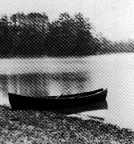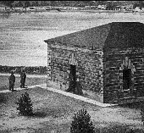|
 Before
1795, Bostonians relied on local wells, rain barrels and a spring on the
Boston Common for their water.
Before
1795, Bostonians relied on local wells, rain barrels and a spring on the
Boston Common for their water.In 1795, private water suppliers developed a delivery system, using wooden pipes made from tree trunks, to deliver water from Jamaica Pond to the City of Boston.
In the 1840s, the City of Boston (pop. 50,000) was faced with water quality and capacity problems. Jamaica Pond was lacking in capacity and becoming increasingly polluted causing several epidemics. There were several disastrous fires that could not be contained due to lack of delivery capacity.
A pure water source had to be found elsewhere.
COCHITUATE SYSTEM 1848-1951
 In
1846, the Cochituate Water Board began construction of a transmission system.
In
1846, the Cochituate Water Board began construction of a transmission system.A tributary of the Sudbury River was impounded, which created Lake Cochituate. Cochituate, with its 17 miles of watershed, 2 billion gallons of storage and yield of 10 mgd, became the cornerstone of the Boston water system. The Cochituate Aqueduct was completed to transport water to the Brookline Reservoir from which pipelines were constructed to small distribution reservoirs in all parts of the city. The first water from Lake Cochituate flowed into the Frog Pond on Boston Common in 1848 at a dedication ceremony which drew 100,000 people.
One of the distribution reservoirs, the Beacon Hill Reservoir, was an elaborate covered facility constructed of granite. the reservoir was demolished to build the addition at the rear of the State House. South Boston High School was constructed at the site of another reservoir.
In 1870, the Mystic Lakes system in Winchester, Medford, and Arlington, which had been developed by Charlestown, was added to the Boston system when Charlestown was annexed. This lake system had a yield of 30 mgd from its 28 square mile watershed. One of the original water mains to Charlestown is still in service.
In 1951, the Cochituate Reservoir and Aqueduct were abandoned. At that
time, there were four aqueducts delivering water to the hub of the system
and the Cochituate system was unnecessary. The water had also declined
in quality and would have required treatment. The Boylston Street Mains
are still in service; some parts will be rehabilitated; others will be
abandoned.
COCHITUATE ERA SUMMARY
|
Go to: Next
Back to: Water System History
Revised:
June 23, 2011